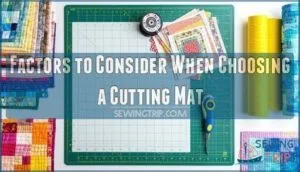This site is supported by our readers. We may earn a commission, at no cost to you, if you purchase through links.
 You’ll want the best cutting mat for quilters that combines durability with precision.
You’ll want the best cutting mat for quilters that combines durability with precision.
Look for self-healing surfaces that resist blade marks and maintain smooth cutting action over time. Size matters – choose 24" x 36" for most projects, though smaller mats work for piecing.
Grid lines should be clearly marked and printed below the surface to prevent wear. Quality mats feature inch markings, angle guides, and bias lines for accurate cuts.
Brands like Olfa, Omnigrid, and Fiskars offer reliable options. Consider thickness too – thicker mats stay flat longer and provide better blade protection.
The right mat becomes your foundation for flawless quilting success.
Table Of Contents
Key Takeaways
- You’ll want a self-healing cutting mat that recovers from blade marks and maintains smooth cutting surfaces for years of reliable use.
- Choose a 24" x 36" size for most quilting projects, though smaller 18" x 24" mats work well for beginners and offer better portability.
- Look for clear grid markings printed below the surface, including inch measurements, angle guides, and bias lines for precise fabric cutting.
- Invest in quality brands like Olfa, Omnigrid, or Fiskars with proper thickness and non-slip backing to ensure stability and extend your rotary cutter blade life.
Importance of a Quality Cutting Mat for Quilters
Investing in a quality quilting cutting mat isn’t just another expense—it’s the foundation of every successful quilting project.
A quality cutting mat is the unsung hero that transforms ordinary fabric into quilting masterpieces.
Your cutting precision directly impacts how well your quilt blocks fit together, and a good self healing mat guarantees clean, accurate cuts every time.
The right rotary cutter mat protects your fabric from snags and tears while providing the stability you need for consistent results.
A professional-grade cutting mat also extends your tool longevity by preventing blade damage that occurs on inferior surfaces. Consider mats with self-healing technology for extended lifespan.
The ergonomic benefits can’t be overlooked either—proper mat thickness reduces hand fatigue during long cutting sessions. When your quilting tools work together seamlessly, you’ll notice improved project stability and fewer frustrating do-overs.
Think of your cutting mat as the silent partner that makes every other quilting tool perform better, ensuring consistent results and improved project stability with fewer frustrating do-overs and a good self healing mat for clean, accurate cuts.
Factors to Consider When Choosing a Cutting Mat
Selecting your quilting cutting mat doesn’t have to feel overwhelming. Smart choices now save frustration later.
Consider these key factors that’ll make or break your cutting experience:
- Size Requirements: Match your workspace and project needs – a 24×36 rotary cutter mat handles most quilts
- Self-Healing Tech: These mats bounce back from cuts, lasting years longer than standard options
- Grid Markings: Clear measurement lines prevent costly fabric mistakes
- Mat Thickness: Thicker self healing mat options provide better durability and cutting precision
Your Storage Needs matter too – some fold while others require flat storage space.
Regular rotation helps extend the mat’s life.
Top Features to Look for in a Cutting Mat
Professional quilters consistently prioritize specific features when selecting their ideal cutting mat.
The right cutting mat transforms your quilting from frustrating guesswork into precise, professional craftsmanship.
Self-healing ability tops the list, allowing your quilting cutting mat to recover from rotary cutter marks and maintain smooth surfaces for years.
A gridded surface provides essential measurement references, helping you achieve precise cuts without constant ruler adjustments.
Size considerations matter tremendously – while a large cutting mat accommodates full fabric widths, smaller mats offer portability for quilting groups.
Mat thickness directly impacts durability and cutting precision, with thicker self-healing mat options lasting longer under heavy use.
Material quality determines how well your quilting tools perform, as premium surfaces grip fabric without sliding while protecting blade edges.
For superior performance, consider mat thickness and size.
Look for non-slip backing that keeps your cutting mat stable during intensive projects.
These core features transform ordinary fabric cutting into precise, efficient quilting preparation that elevates your finished projects.
Comparison of The Best Cutting Mats for Quilters
Now that you understand the key features, let’s examine how the top quilting cutting mat options stack up against each other. Brand comparison reveals distinct differences in performance and value.
| Mat Brand | Best For | Standout Feature |
|---|---|---|
| Olfa Soft Grip | Professional quilters | Gold standard reliability |
| Crafty World Professional | Budget-conscious users | Multiple size options |
| Nicapa | Value seekers | Superior performance at lower cost |
Size matters when choosing your fabric cutting mat. The Fiskars large cutting mat offers 24 x 36-inch workspace, while Crafty World provides three compact options.
Self-healing tech varies between brands, with Olfa leading in durability. Many quilters prioritize mats with superior self-healing capabilities.
Grid accuracy differs substantially—some mats feature precise measurements while others compromise on clarity. Portability options range from lightweight travel designs to heavy-duty professional models.
Your best quilting tools investment depends on matching these features to your specific needs and workspace requirements.
Frequently Asked Questions (FAQs)
Which rotary cutting mat is best for quilting?
Like knights of old needed trusty shields, you’ll want Olfa’s self-healing rotary cutting mat as your quilting companion.
It’s the gold standard – bounces back from cuts, grips fabric securely, and won’t dull your blade prematurely.
Is a cutting mat necessary for quilting?
You absolutely need a cutting mat for quilting.
It protects your table, provides precise measurements, and enables clean rotary cuts.
Without one, you’ll struggle with accuracy and likely damage your work surface.
What is a large cutting mat for quilting?
A large cutting mat for quilting typically measures 24" x 36" or bigger, providing ample workspace for cutting full fabric widths.
You’ll get more accurate cuts and reduce fabric repositioning when working on extensive quilting projects that require accurate cuts.
Which cutting mat is best for quilting & scrapbooking?
Your cutting mat choice can make or break your crafting experience.
For quilting and scrapbooking, you’ll want a self-healing mat with precise grid lines.
The 24″ x 36″ size offers versatility for both hobbies perfectly.
How do I choose a quilt mat?
Consider your workspace size first – 18"x24" suits most beginners, while 24"x36" handles larger projects.
Choose self-healing mats for durability, gridded surfaces for precision, and non-slip backing for stability during cutting.
What are the different types of quilting mats?
Which mat will become your quilting companion?
You’ll find self-healing mats that reseal after cuts, non-slip mats for stability,
rotating mats reducing wrist strain, and gridded surfaces ensuring precise measurements and alignment.
This mat selection includes various types, such as non-slip mats for stability.
What size cutting mat do I need for quilting?
For beginners, you’ll want an 18" x 24" mat that handles most projects comfortably. If you’re tackling larger quilts or long border strips, upgrade to a 24" x 36" mat for maximum cutting space.
What is the difference between A1 and A2 cutting mats?
A1 mats measure approximately 23" x 33" while A2 mats are smaller at 16" x 23".
You’ll get more cutting space with A1, but A2’s compact size makes it perfect for travel and smaller workspaces.
What kind of cutting surface do you need to quilt?
You’ll need a self-healing cutting mat with gridded measurements for precise fabric cutting.
Choose one that’s stable, non-slip, and sized appropriately for your workspace—it protects surfaces while enabling clean rotary cuts.
How often should I replace my cutting mat?
Studies show 70% of quilters use worn-out mats longer than recommended.
You should replace your cutting mat when shallow cuts become deep grooves and the surface feels rough, typically every 2-3 years with regular use, as this is when the mat is considered worn-out.
Conclusion
Selecting your quilting companion doesn’t have to feel like traversing a maze.
The best cutting mat for quilters transforms your workspace into a precision zone where every slice counts.
Whether you’re piecing intricate blocks or cutting yards of fabric, these top-rated mats deliver the durability and accuracy your projects deserve.
Your quilting journey becomes smoother when you’ve got the right foundation beneath your rotary cutter.
Invest wisely, and you’ll enjoy years of flawless cutting performance.





